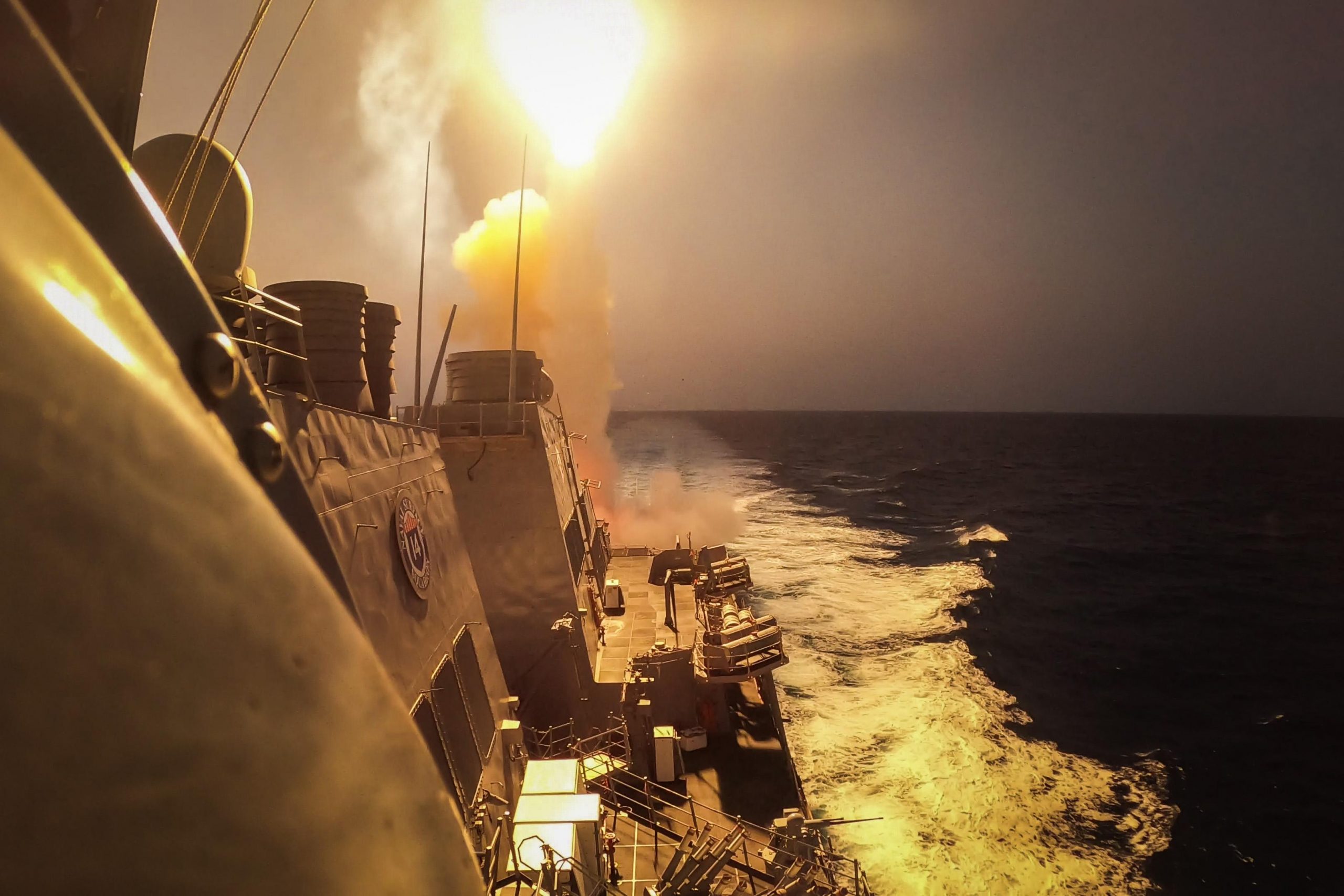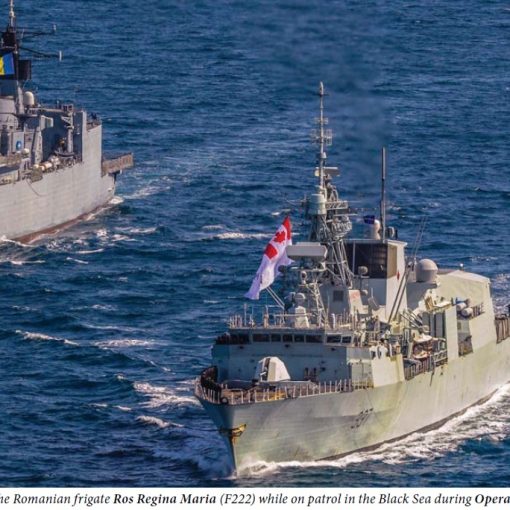By Dr. Ann Griffiths, 15 January 2024
If anyone is wondering about the relevance of navies in 2024, then there is an obvious role now – protection of shipping. Yemen-based Houthis are making the Red Sea a no-go area for shipping. They have used drones, ballistic missiles, cruise missiles and small explosive-laden boats to target ships in the Red Sea off Yemen (the group has noted it might also target ships in the Arabian Sea and the Gulf of Aden). Their actions are ostensibly undertaken in support of Palestinians in Gaza and were originally said to target only those ships with ties to, or bound for, Israel, although their focus seems to have broadened to include pretty much any ship passing by. Many shipping companies are now re-routing their ships around Africa instead of using the shorter route through the Suez Canal. This has major implications. Egypt will not receive millions of dollars of revenue for passage through the canal, which it can ill afford to lose. Insurance rates have gone up, container costs have increased, the longer route means delays, more fuel, more pay to crew (including additional security personnel). The events are already starting to pinch in Canada – apparently two-thirds of the 43 ships scheduled to arrive in Halifax in the remaining weeks of January are likely to arrive at least a day behind schedule, with some weeks late.[1]
In response to the attacks, the United States initiated Operation Prosperity Guardian in December. This has involved deploying a number of US Navy warships, as well as British and French warships to the area. Along with some European states, Canada has supported the operation – not with ships but apparently with three CAF staff officers, whose contribution is unknown. (Missing from public support of the operation are Middle Eastern countries.)
The problem is that the presence of warships has not deterred the Houthis. Missiles and drones continue to be launched at ships in the area. The US, UK and French warships have successfully intercepted the vast majority of missiles and drones, illustrating the efficacy of their anti-air capabilities. But the plot thickens. On the night of 11/12 January, the USN and Royal Navy carried out airstrikes on sites in Yemen. The Houthis have vowed revenge. Iran has sent a warship into the area.
The Houthis were losing support among Yemenis because of poor governance but this action in support of Palestinians has increased their support, both at home and with populations in the Middle East. Airstrikes in Yemen increase the popularity of the Houthis even more.[2] This continuing crisis raises many questions. How effective is deterrence against determined non-state groups? Despite the warships, shipping companies are using the alternate route. Thus, how effective are warships to counter land-based attacks against ships in chokepoints? Since it seems to be working, will this strategy be used in other shipping channels? Many people have worried that the conflict in Israel will metastacize into a broader conflict, but most predicted it would spread via the West Bank, or Hezbollah in Lebanon, or Iran, but perhaps Yemen will be the match that lights the fire?
Interestingly, two major shipping canals in the world – the Suez Canal and the Panama Canal – are both suffering right now. The Suez Canal is threatened by missiles and the Panama Canal by drought. Just when the mess caused by the pandemic got unsnarled, we get two new wrinkles in global shipping.
[1] “Tremors from Red Sea conflict start to shake Canada, with dozens of ships delayed,” The Canadian Press, 15 January 2024, Tremors from Red Sea conflict start to shake Canada, with dozens of ships delayed (msn.com)
[2] For a good discussion of this, see International Crisis Group, “What Next after US and UK Strikes on the Houthis?” 13 January 2024, What next after U.S. and UK strikes on the Houthis? | Crisis Group






7 thoughts on “Red Sea Attacks and Naval Response”
The protection of Maritime shipping has been talked about by other Canadian organizations and individuals for several years now. The only reason it hasn’t had the urgency or priority is that most Canadians believed that it would not hit our shores. Well, the “chicken has come home to roost”! The Yemen-based Houthis (supported by Iran) are making the world a much more dangerous place and seem to be striking any vessels in the Red Sea which are just passing through and they have the modern means to accomplish their goals whether it be using helicopters, drones or ballistic/cruise missiles. With Iran sending a warship into the area, this should send a clear message to all allied nations including Canada. The US, UK and France have all responded to this aggression by sending warships and aircraft to the area to protect shipping but they cannot do this all by themselves. Yes, their response has included strikes on Yemen-based Houthis land positions which has done nothing to quell the Houthis other than cause them to be even more angered. Threats to maritime security are threats to Canada’s sovereignty and economic well-being. Virtually all of Canada’s imports from countries other than the United States come via the world oceans including the Red Sea. So, what has been Canada’s response? We sent 3 officers to help coordinate American lead strike responses in the area. This is too little, too late. What is needed is an allied quick response task group strike force led by NATO with at least one Canadian CPF as part of that force from a host of NATO countries to help protect all allied shipping in the Red Sea area. Will, or more precisely, can, Canada properly respond to this Maritime shipping crisis or do Canadians even care? With the state of the RCN right now perhaps not. Canada must respond to this threat with some sort of naval maritime presence or risk being even more marginalized by our allies.
The leadership in Canada has no will, no stomach, no fortitude to conduct exercises. Any new equipment is far in the future and will be outdated when our military gets it.
The Houthi missile attacks from Yemen once again highlight the vulnerability of global shipping routes to relatively inexpensive weapons. But much like the ubiquity of drone warfare in Ukraine, western navies must carefully consider the relevance of these attacks and how they might be countered.
First, we must be cautious about embracing the idea of the supreme importance of drones and relatively cheap ballistic missiles in naval conflicts. Much of what has been written is as yet incomplete and speculative.
Second, the operations in the Red Sea, the Middle East, and Ukraine are situated in relatively confined geographic locations close to land bases. Thus, the lessons navies might draw for these incidents are far different than they might be if we consider naval operations in the vast reaches of the open seas.
Third, as some commentators have pointed out, a mainly defensive strategy is probably a losing proposition in the long run. Defences have to be almost 100 percent successful, and inevitably, some of these low cost weapons will find their mark. We simply do not know how many attacks have not been successful, even if the targets were missed. Avoidance of these traditional shipping routes might be a better approach, even though delays will result, shipping insurance rates will escalate, and consumers will pay more.
Fourth, Western navies are on the wrong side of the cost-effectiveness curve in trying to combat relatively cheap drones and ballistic missiles, with the attackers’ costs in the thousands to tens of thousands of dollars US. Contrast this with: US Standard missiles at $4-5 million USD each plus Tomahawk TLAM missiles at an export cost of $4 million USD; UK Aster/Sea Viper missiles at 1-2 million pounds each; France Aster 15 missiles at $1.1 million USD each.
Again, we only receiving scattered information on the toll that these shipping protection missions are exacting on Western navies. The British navy is expending significant resources on missiles (again, we do not know about the misses), and is apparently hard-pressed to find replacement ships. (See, “HMS Diamond ‘not enough missiles’ for sustained fight”, UK Defence Journal,14 Jan 2024,
https://ukdefencejournal.org.uk/hms-diamond-not-enough-missiles-for-sustained-fight/; and
Paul McCleary, “As the Middle East heats up, the Navy struggles to
deploy replacement ships”, politico.com, 12 January 2024)
https://www.politico.com/news/2024/01/12/as-the-middle-east-heats-up-the-navy-struggles-to-deploy-replacement-ships-00135337)
Similarly, the French navy is running through expensive missile ordnance at a high rate.
(See, Rudy Ruitenberg, “French Navy defends use of million-euro missiles to
down Houthi drones”, defensenews.com, 11 January 2024)
https://www.defensenews.com/global/europe/2024/01/11/french-navy-defends-use-of-million-euro-missiles-to-down-houthi-drones/)
Fifth, one partial technological solution for navies is to develop less expensive air defence systems. However, despite some promising early progress, deploying cheaper-per-shot directed energy defences has yet to be fully realized. (See, Justin Katz, “‘It’s hard’: Navy needs to be realistic about laser weapons, admiral says”, breakingdefense.com, 11 Jan 2024)
I will leave it to Forum readers to draw their own conclusions as to what the foregoing portends for the Canadian Navy.
With regards to HMS Diamond she has 48 Aster 15 / 30 (ceptor) missiles however her original tasking was not this so like nearly all warships will likely have sailed with reduced load.
Secondly there’s another issue and that is the whole saga of ‘fitted for but not with’ as the Type 45 can be fitted for another 16 cell MK41 VLS and since their builds this has been a common criticism.
As of now we have HMS Iron Duke heading to the Red Sea and HMS Lancaster is already on station out that way on extended deployment
When this started, the warnings were given and unheeded. Hit them hard and hit them again as an example to pirates and terrorists and to those who are arming them. As for using expensive missiles for downing simple drones and ballistic missiles, then develop a low cost missile especially for drone defense and come up with some other sort of defence that could be mounted on commercial vessels.
When Hamas attacked Israel on 7 October, my first thought was why. Were the attacks a metaphorical tap on the shoulder (slap to the face) to encourage a recalcitrant Israel to come back to the negotiating table? Likely not. Hamas is committed to Israel’s destruction, not a two-state solution. More likely it was a means to political self-aggrandizement by Hamas – a way of bolstering its own political fortunes in the Occupied Territories and among wider Arab public opinion. It may also have been a way for its sponsor, Iran, to de-rail Israeli plans to continue the process of political normalization with its Arab neighbours, which Tehran vehemently opposes. Hamas and Iran evidently believed that a particularly nasty attack would prompt Israel to respond with everything it had, and suffer extreme reputational damage as a result. It laid a trap and Netanyahu obligingly walked into it.
What to make of the Houthis? Much like the Taliban, they are a more of a political movement than an entity concerned with governance. What do they have to offer their people, aside from more hardship? So, what better way of diverting attention from their sorry predicament than picking a fight, allegedly on behalf of Palestinians? (They couldn’t give a fig about Palestine, any more than did Saddam Hussein who, facing a massive coalition in 1990-91, proclaimed that he’d withdraw from Kuwait if Israel withdrew from the Occupied Territories. No one, save Arafat, took him seriously.)
I see the same dynamic at work in the Red Sea as in Gaza – only now it is the US and some allies who are falling into a trap set by Iran and its proxy. The mullahs are still smarting from last’s year’s internal convulsions, and a succession crisis looms (who will replace Khamenei when he croaks). Combine that with Tehran’s desire to demonstrate its ability to control key choke points – i.e., the Strait of Hormuz, and now the Bab el-Madeb – and you have all the ingredients for another stand-off. Iran knew that the US wouldn’t stand for the closure of the southern Red Sea to shipping, so now Washington has locked itself into a low-level conflict that it simply may not be able to sustain. (Despite a (grudging) international consensus that attacks on international shipping are unacceptable, the US is again obliged to carry the most of the burden.) This while the so-called ‘Axis of Resistance’ revels in its new-found prestige – at least in its own mind.
As I observed in my 10 Jan post under the Broadside on re-assessing the CSC’s missile load, and as Dr. Middlemiss observes here, any naval coalition that pits itself against a persistent, plentiful, but relatively cheap threat will eventually find the loss-exchange ratio to be unfavourable. In other words, ships will expend too many pricey munitions to achieve a high probability of kill. The stand-off is materially and financially unsustainable unless a full naval blockade of Houthi-controlled coastline is instituted, and who will support that diplomatically, let alone underwrite it with enough ships? The whole affair will only breed frustration in Washington as the US heads into perhaps its most consequential election since 1860.
It may be too late to change course now, but rather than taking Iran’s bait, perhaps shipping should be re-routed for the time being. This does not amount to capitulation. Rather, I would argue that it is an exercise in strategic patience in which responsibility for disorder at sea is placed firmly on the shoulder of those who have imperiled shipping. Meanwhile, all regional states, as well as those depending on maritime trade (including and especially China) should be rallied together to bring political pressure on Iran to rein in its proxy. They should be made to understand that their justifications are not credible, and that if shipping traffic drops off precipitously, they will be forced to take ‘credit’ for the economic disruption that results.
And the Houthis will have much more to answer for. By threatening any ship passing through the southern Red Sea, they are making their own people even more wretched. Most of their food shipments come into the port of Hodeidah. Fighting will simply dissuade ships from calling in there.
https://www.theguardian.com/world/2024/jan/15/airstrikes-houthis-aidarus-al-zoubaidi-yemen#:~:text=%E2%80%9CAirstrikes%20on%20their%20own%20are,storage%20systems%20for%20their%20artillery.%E2%80%9D
So, let’s not act as our adversaries predict. Let’s present them with strategic dilemmas instead. Let the disruptors of good order at sea pay a political price for their actions. And let the ‘Axis of Resistance’ be exposed for the fraud that it is.
Hello Barnacle Bill. I tend to totally agree with much of what you have said. Although the use of the Suez Canal would substantially stop with only local marine traffic and allied Naval vessels utilizing it until this crisis is resolved diplomatically. Re-routing all Maritime shipping including all Tankers, Container and Cargo vessels will be costly for most of the world for a while (short-term pain for long-term gain), it is probably the best option to curtail all of Houthis efforts. As you say, the Houthis are just another terrorist organization supplied by Iran as is Hamas with no intention or thoughts of “statehood” but the complete destruction of one state and those who support that one state. If Iran were, for all intense-and-purposes, to be neutralized somehow by a re-invigorated world order, that would go a long way to de-escalating most tensions in the Middle East. Once most Maritime traffic essentially stopped, all Naval nations, and their allies would be good-to-go into the Red Sea and finish the job once and for all. Yes that would require a much more strengthened coalition (led by the US/NATO no doubt) but its effect would be a game changer. Canada would also have to seriously consider contributing a naval presence to this coalition force as well. The only problem with that theory is Russia and possibly North Korea. But if China were to possibly “rein-in” both of those countries, that would certainly go a long way to resolve this crisis and let the world get back to cruising the Red Sea without fear. My thoughts anyway. Cheers!